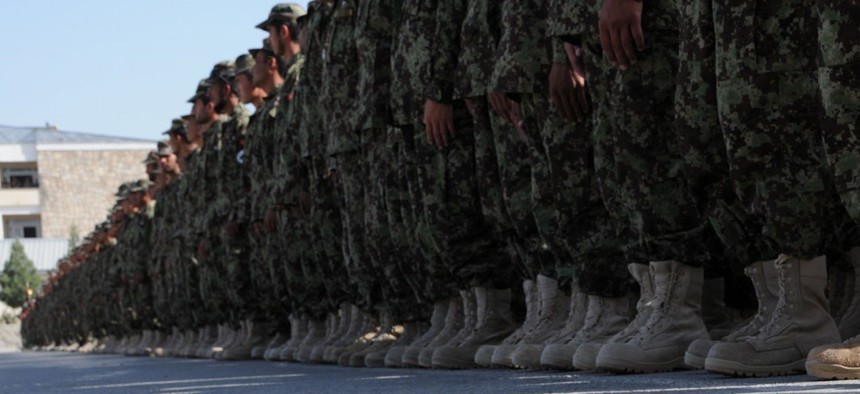U.S. Wastes $28 Million on Afghan Soldiers's Uniforms, Watchdog Says
A report deemed the camouflage pattern inappropriate for a country that is only 2.1 percent forest.
The Pentagon wasted as much as $28 million over the last decade on camouflage uniforms for Afghan soldiers despite the fact forests make up only a small fraction of the country’s landscape, according to a report released Wednesday by the Special Inspector General for Afghanistan Reconstruction (SIGAR).
The findings comes a decade after the Department of Defense moved to procure new uniforms for Afghanistan’s National Army as part of U.S. efforts to bolster the country’s capacity to provide its own security. The uniforms, which cost approximately $93 million, were made using a “forest” pattern from a company called HyperStealth—one which the report says was chosen over other free camouflage patterns owned by the U.S. government after Afghanistan’s defense minister at the time, Gen. Abdul Rahim Wardak, “liked what he saw” on the company’s website.
This decision was problematic. As SIGAR noted in its report, the “forest” color was chosen “despite the fact that forests cover only 2.1 percent of Afghanistan’s total land area.” This didn’t go unnoticed by HyperStealth, which acknowledged in a February 2010 press release that the forest design may seem an “odd choice” for Afghanistan.
John Sopko, the special inspector general for Afghanistan Reconstruction, called the move “insane.”
“This is just simply stupid on its face,” Sopko told USA Today. “We wasted $28 million of taxpayers’ money in the name of fashion, because the defense minister thought that that pattern was pretty. So if he thought pink or chartreuse was it, would we have done that?”
Indeed, the report concluded that the uniforms added between $26 million and $28 million to the overall cost of the uniforms, adding that changing the uniforms could save the U.S. between $68 million and $72 million over the next decade.
The Pentagon did not dispute its findings.
“DoD concurs in the suggestion contained in this report that a DoD organization with expertise in military uniforms should conduct a cost-benefit analysis of the current Afghan National Army (ANA) uniform specifications to determine whether there is a more effective alternative, considering both operational environment and cost,” Jedidiah Royal, the acting deputy assistant secretary of defense for Afghanistan, Pakistan, and Central Asia, said in a statement.




